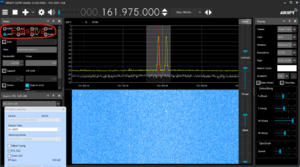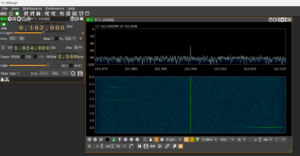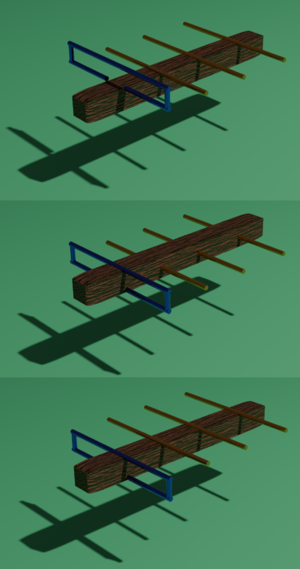RTL-SDR AIS Ship Tracking
Introduction
- AIS: Automatic Identification System.
- RTL
- SDR: Software Defined Radio
- Also: ADS-B (Automatic Dependent Surveillance-Broadcast) for aircraft surveillance. 1090 MHz
Need a radio dongle, antenna. Use Arduino and RPi.
RTL-SDR V3
My dongle seems to be original, according to https://www.rtl-sdr.com/rtl-sdr-blog-v-3-dongles-user-guide/
V3 Datasheet is at https://www.rtl-sdr.com/wp-content/uploads/2018/02/RTL-SDR-Blog-V3-Datasheet.pdf
- Install the custom drivers in order to make the V4 work
- RTL-SDR Blog driver fork from https://github.com/rtlsdrblog/rtl-sdr-blog.
- Release.zip file from the Releases page. For SDR# extract the rtlsdr.dll file from the x86 folder to the SDR#. For most other x64 programs, use the rtlsdr.dll file in the x64 folder.
Software
Frequencies 161.975 MHz and 162.025 MHz, thus by adjusting the frequency to 162.000MHz we can listen to both frequencies. Marine VHF is narrow band (NFM) Ch16 is on 156.8MHz.
- AM: Amplitude Modulation
- FM: Frequency Modulation
- NFM: Narrow Frequency Modulation, 16kHz bandwidth which comes from +/-5kHz frequency deviation.
- WFM: Wide Frequency Modulation
- SSB: Single Side Band. See https://ccrane.com/ssb-frequency-lists/
- LSB: Lower Side Band
- USB: Upper Side Band
- CW: Continuous Wave (Morse Code)

SDRSharp, SDR#
SDR#, brief tutorial:
- set your audio piping method in the Audio output drop down box
- tune to an AIS frequency (161.975 MHz or 162.025 MHz). the signals may not appear exactly on the AIS frequencies (the RTL-SDR is not frequency accurate (unless you have a RTL-SDR with TCXO)). Tune manually until the signals are properly centered, or set the PPM offset correctly.
- adjust the RF gain such that the signal is strong, but the noise floor is low.
- use a program for decoding:
- AISdeco2 not working anymore (2024)
- SDRangel: https://github.com/f4exb/sdrangel/blob/master/plugins/feature/ais/readme.md and Wiki Home
- AIS Catcher: https://github.com/jvde-github/AIS-catcher?tab=readme-ov-file
AISCatcher
https://www.youtube.com/watch?v=8wRIYuFXOqE
- In built-web server:
AIS-catcher -v 10 127.0.0.1 -M DT -N 8100
- Use external data from https://airspy.com/directory/:
AIS-catcher -v 10 127.0.0.1 -M DT -N 8100 y 37.136.93.253 5000
AirSpy
OpenCPN is a plotter.
AISmon
SDRangel

-
Radio properties of the Default AIS settings [See Configuration Presets, a star]. L SR is 1,000,000 S/s, RFBW is 2,5000 kHZ, Gain is 42.1
-
Frequencies and signals.
-
The Data
-
The Data
-
Also the map
- Wiki https://github.com/f4exb/sdrangel/wiki
- More than only a AIS decoder.
- See https://www.youtube.com/watch?v=zugH-7yn-Mc for more information, and Jeremy Clark's web page https://jeremyclark.ca/wp/telecom/rf-signal-propagation-calculations_splat/
AIS Data received
- Date. Eg: Tue Jun 18 2024
- Time. Eg: 12:07:49
- MMSI: Maritime Mobile Service Identity. Eg: 230011000
- Country. Eg:
- Type. Eg: Static data report // Standard Class B equipment position report // Ship static and voyage related data // Position report (Scheduled) // Position report (Interrogated) // Data link management message // Base station report //
- Id. Eg:
- Data. Eg: Type: Vessel - Sailing Vendor ID: SRTH%GM Callsign: OH8682 // Type: Vessel - Pleasure craft Vendor ID: AMC@ANM Callsign: OH6573 // Name: MAIJU // Lat: 91° Lon: 181° Speed: 102.3 knts Course: 360° Status: Moored // Lat: 59.5295° Lon: 24.7398° Speed: 24.2 knts Course: 339.7° Status: Under way using engine // Lat: 59.5168° Lon: 24.8398° Tue Jun 18 09:37:29 2024 GMT // IMO: N/A Callsign: ES2735 Name: AHTO-28 Type: Pilot vessel Destination: MUUGA //
- NMEA 0183(?) (National Marine Electronics Association). See https://pypi.org/project/pyais/ Eg: !AIVDM,1,1,,,13KIo6P000QiV=:R2p;u2Db@2H59,0*4b // !AIVDM,1,1,,,13KtJ`04PaQiHGJR0w6j2GWT0D2I,0*08
// !AIVDM,1,1,,,347eHF50P0QiIBRR0qsWLFgN2000,0*2e // !AIVDM,2,1,1,,54cac6429V2GQ1=2221LTi<tr20QDl8E:22222169p;975SV091AE33888888,0*73
!AIVDM,2,2,1,,8888888880,2*5c
- Hex. Eg: 14420221e2025bcd4854cc4800003594d40520000000000000000000003d0baf92485a497914515604ef2df8624814c00000000000 // 0441fbd883e0000871275fa2059611b9ffac008364
- Slot. Eg:
NMEA
NMEA 0183(?) (National Marine Electronics Association). See https://pypi.org/project/pyais/ or https://gpsd.gitlab.io/gpsd/AIVDM.html
- Comma-separated fields, eg !AIVDM,1,1,,B,15MwkT1P37G?fl0EJbR0OwT0@MS,0*4E
- !AIVDM: the sentence is an AIS message in the "VDM" (VDO Message) format.
- 1,1: the total number of sentences in the message and the current sentence number, respectively.
- Blank
- B: the communication channel. In this case, the channel is "B".
- 15MwkT1P37G?fl0EJbR0OwT0@MS: the message in Six-bit ASCII.
- 0*4E: a checksum.
- Eg, Position Report" message: position, course, and speed.
Eg: !AIVDM,1,1,,,13KIo6P000QiV=:R2p;u2Db@2H59,0*4b // !AIVDM,1,1,,,13KtJ`04PaQiHGJR0w6j2GWT0D2I,0*08 // !AIVDM,1,1,,,347eHF50P0QiIBRR0qsWLFgN2000,0*2e // !AIVDM,2,1,1,,54cac6429V2GQ1=2221LTi<tr20QDl8E:22222169p;975SV091AE33888888,0*73
!AIVDM,2,2,1,,8888888880,2*5c
Theory -- AIS decoding
https://www.rtl-sdr.com/rtl-sdr-tutorial-cheap-ais-ship-tracking/
Radio Dongle
https://www.rtl-sdr.com/buy-rtl-sdr-dvb-t-dongles/
https://www.ebay.com/str/rtlsdrblog
Antenna
The frequency of AIS signal is 161.975 MHz and 162.025 MHz, and have the max range of about 70 km. Is is a line of sight signal. I wish to have 180 degrees view.
I decided to make two different Yagi antennas both working at 162.0 MHz. Both antennas have the reflecting and driven (dipole) elements, and two (2) or three (3) directional elements. The dimensions (given by k7mem, using non-metallic boom, boom diameter 20mm and element diameters 2.5 mm) are following:
| Gain | Hor beam width | Refl pos | DE pos | D1 pos | D2 pos | D3 pos | |
|---|---|---|---|---|---|---|---|
| 2 Element Lengths |
4.007 dBd | Nan deg | 0 | 370.11 | |||
| 907.55 | 901.08 | ||||||
| 3 Element Lengths |
5.382 dBd | 75.9 deg | 0 | 370.11 | 508.91 | ||
| 907.55 | 901.08 | 840.99 | |||||
| 4 Elements Lengths |
6.756 dBd | 59 deg | 0 | 370.11 | 508.91 | 842.01 | |
| 907.55 | 901.08 | 840.99 | 835.12 | ||||
| 5 Elements Lengths |
8.003 dBd | 52.0 deg | 0 | 370.11 | 508.91 | 842.01 | 1239.88 |
| 907.55 | 901.08 | 840.99 | 835.12 | 827.89 |
Driven element is a dipole element [or actually a half-dipole], thus the length should be (m). A slightly different number for speed of light (speed of radio waves in the antenna; ) makes the to be m. The driven element has an additional parallel wire connecting its two ends, and is called a folded dipole. Thus two nearly identical radiating currents are generated. See loop antenna. Folded dipole consists of a split dipole and an unbroken impedance transformer, and those two elements are connected together at both ends. The gap should be fixed to keep the wires at a constant separation distance. Spacing is the distance between the two parts of the driven element.

There are three (3) common mounting types of driven elements: below, top or middle (see the image). Actually the mounting point do not matter. A good method to connect the wires to the driven element is to flatten the ends and attach the wire with a small nut and bolt, or use soldering iron.
Feeding. Normally the feeding impedance is 300 Ω. Impedance matching (if 75 Ω coaxial cable)
https://www.k7mem.com/Ant_Yagi_VHF_Feed.html#Mounting
https://www.k7mem.com/Ant_Folded_Dipole.html#Page_Top
https://www.k7mem.com/Ant_Yagi_VHF_Feed.html
Material: Common 1/4" copper tubing is often a good choice, or aluminum tubing, or #14 AWG electrical wire (diameter 1.6 mm and area 2.08 mm2).
Other antenna types I considered:
- Quarter wave / dipole. One vertical 1/4 wave element connected to the center of the coax cable and 4 (or more) more grounding elements pointing towards the the ground at 45 deg. A quarter wave antenna calculator: https://jeroen.steeman.org/Antenna/Quarter-Wave-Antenna-Calculator
- Coax collinear antenna. Very high omnidirectional gain. Multiple short coax cables where the outer conductor is connected to the inner conductor in an alternating fashion.
- Slim Jim.
https://arundaleais.github.io/docs/ais/aerial.html
Refs:
- https://www.rtl-sdr.com/rtl-sdr-tutorial-cheap-ais-ship-tracking/
- https://www.waves.utoronto.ca/prof/svhum/ece422/notes/13-folded.pdf
Programming
Raspberry Pi AIS
I will use an old Raspberry Pi 2B model for this.
- Allow SSH: GUI: Preferences -> Raspberry Pi Configuration -> Interfaces -> SSH.
- Start to CLI, no graphical user interface: Preferences -> Raspberry Pi Configuration -> System -> Boot To CLI.
- User name: mol, server name: raspi
- Find the IP address using a Windows and Zenmap:
nmap -p 22 192.168.8.0/24or check the topology.- OLD: Find the IP address using a Windows:
Wiresharkand use the following display filtereth.addr[0:3] == B8:27:EB. ?????
- OLD: Find the IP address using a Windows:
- Use WinSCP and PuTTY. I know how to use them.
After pluged in,
lsusbshows0bda:2838 Realtek Cemiconductor Corp. RTL2939 DVB-T.- install osmocom drivers.
Aim: To listen the data and to send it to a MySQL database for further usage. Also, take some photos.
- https://ranous.wordpress.com/wp-content/uploads/2018/02/rtl-sdr4linux_quickstartv2-18.pdf
- https://github.com/jvde-github/AIS-catcher
- https://www.klofas.com/blog/2021/ais-decoding-with-rtl-sdr-dongle/
- https://www.satsignal.eu/raspberry-pi/AIS-receiver.html
- https://github.com/mcqn/shpi-ais
- https://github.com/dgiardini/rtl-ais
- https://www.sarcnet.org/ais-receiver.html
- https://forums.raspberrypi.com/viewtopic.php?t=115380
- https://www.stripydog.com/kplex/







